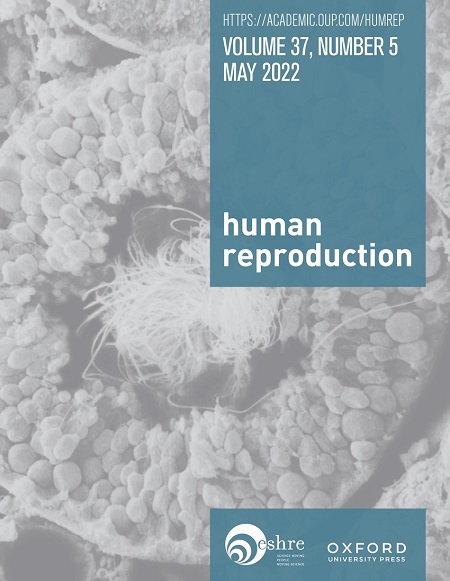Dietary patterns and age at menarche in a prospective study of girls in the USA.
IF 6
1区 医学
Q1 OBSTETRICS & GYNECOLOGY
引用次数: 0
Abstract
STUDY QUESTION Are dietary patterns associated with age at menarche after accounting for BMI-for-age (BMIz) and height? SUMMARY ANSWER We observed associations between both the Alternative Healthy Eating Index (AHEI) and the Empirical Dietary Inflammatory Pattern (EDIP) and age at menarche. WHAT IS KNOWN ALREADY Dietary patterns have been sparsely examined in relation to age at menarche and no studies have examined the association between the AHEI, a healthier diet, and EDIP, a pro-inflammatory diet, and menarche. STUDY DESIGN, SIZE, DURATION The Growing Up Today Study (GUTS) is a prospective cohort of children ages 9-14 years at study enrollment. GUTS enrolled in two waves with enrollment beginning in 1996 (GUTS1) and 2004 (GUTS2). For this analysis, GUTS1 and GUTS2 participants were followed through 2001 and 2008, respectively. PARTICIPANTS/MATERIALS, SETTING, METHODS We included 7530 participants who completed food frequency questionnaire(s) (FFQ) prior to menarche who then self-reported age at menarche during study follow-up. Cox proportional hazard models were used to calculate multivariable hazard ratios (HRs) and 95% CIs for the associations between two dietary patterns, the AHEI and EDIP, and age at menarche, with and without adjustment for time-varying BMIz and height. MAIN RESULTS AND THE ROLE OF CHANCE Six thousand nine hundred ninety-two participants (93%) reported menarche during the study period. On average, participants completed the baseline FFQ 1.75 years prior to menarche. Participants in the highest quintile of AHEI diet score (indicating a healthier diet) were 8% less likely to attain menarche within the next month compared to those in the lowest quintile (95% CI = 0.85-0.99; Ptrend = 0.03). This association remained after adjustment for BMIz and height (corresponding HR = 0.93; 95% CI = 0.86-1.00; Ptrend = 0.04). Participants in the highest quintile of the EDIP score (i.e. most inflammatory diet), were 15% more likely to attain menarche in the next month relative to those in the lowest quintile (95% CI = 1.06-1.25; Ptrend = 0.0004), and the association remained following adjustment for BMIz and height (corresponding HR = 1.15; 95% CI = 1.06-1.25; Ptrend = 0.0004). LIMITATIONS, REASONS FOR CAUTION Self-reported questionnaires are subject to some error; however, given our prospective study design it is likely this error is non-differential with respect to the outcome. WIDER IMPLICATIONS OF THE FINDINGS Our findings of an association between both the AHEI and EDIP and age at menarche indicate that diet quality may play a role in age at menarche independent of BMI or height. STUDY FUNDING/COMPETING INTEREST(S) This work was supported by the Breast Cancer Research Foundation. The GUTS is supported by the National Institutes of Health U01 HL145386. C.P.D. was supported by National Institutes of Health T32 CA094880. The authors have no conflicts of interest to disclose. TRIAL REGISTRATION NUMBER N/A.饮食模式和月经初潮年龄在美国女孩的前瞻性研究。
研究问题:在考虑bmi -age (bmi -age, bmi -age)和身高后,饮食模式与月经初潮年龄有关吗?我们观察到替代健康饮食指数(AHEI)和经验饮食炎症模式(EDIP)与月经初潮年龄之间的关联。饮食模式与月经初潮年龄之间的关系研究很少,没有研究调查过AHEI(更健康的饮食)和EDIP(促炎饮食)与月经初潮之间的关系。研究设计、规模、持续时间“今日成长研究”(GUTS)是一项前瞻性队列研究,研究对象为9-14岁的儿童。该系统分两波招生,分别从1996年(GUTS1)和2004年(GUTS2)开始。在这项分析中,分别对GUTS1和GUTS2参与者进行了2001年和2008年的随访。参与者/材料,环境,方法我们纳入了7530名参与者,他们在月经初潮前完成了食物频率问卷(FFQ),并在研究随访期间自我报告月经初潮时的年龄。采用Cox比例风险模型计算两种饮食模式(AHEI和EDIP)与月经初潮年龄之间的多变量风险比(hr)和95% ci,并对随时间变化的bmi和身高进行调整。主要结果和偶然性的作用:在研究期间,有六千九百九十二名参与者(93%)报告月经初潮。平均而言,受试者在月经初潮前1.75年完成基线FFQ。AHEI饮食评分最高的五分之一的参与者(表明更健康的饮食)在下个月内达到月经初潮的可能性比最低五分之一的参与者低8% (95% CI = 0.85-0.99;p趋势= 0.03)。在调整bmi和身高后,这种关联仍然存在(相应的HR = 0.93;95% ci = 0.86-1.00;p趋势= 0.04)。EDIP评分最高的五分之一(即最具炎症性的饮食)的参与者在下个月出现月经初潮的可能性比最低五分之一的参与者高15% (95% CI = 1.06-1.25;p趋势= 0.0004),调整bmi和身高后相关性仍然存在(相应的HR = 1.15;95% ci = 1.06-1.25;p趋势= 0.0004)。自报问卷存在一定的误差;然而,考虑到我们的前瞻性研究设计,这种误差很可能与结果无关。研究结果的更广泛意义:AHEI和EDIP与月经初潮年龄之间的关联表明,饮食质量可能在月经初潮年龄中发挥作用,而与BMI或身高无关。研究经费/竞争利益(S)这项工作由乳腺癌研究基金会支持。GUTS由美国国立卫生研究院U01 HL145386提供支持。cppd由美国国立卫生研究院T32 CA094880资助。作者没有需要披露的利益冲突。试验注册号/ a。
本文章由计算机程序翻译,如有差异,请以英文原文为准。
求助全文
约1分钟内获得全文
求助全文
来源期刊

Human reproduction
医学-妇产科学
CiteScore
10.90
自引率
6.60%
发文量
1369
审稿时长
1 months
期刊介绍:
Human Reproduction features full-length, peer-reviewed papers reporting original research, concise clinical case reports, as well as opinions and debates on topical issues.
Papers published cover the clinical science and medical aspects of reproductive physiology, pathology and endocrinology; including andrology, gonad function, gametogenesis, fertilization, embryo development, implantation, early pregnancy, genetics, genetic diagnosis, oncology, infectious disease, surgery, contraception, infertility treatment, psychology, ethics and social issues.
 求助内容:
求助内容: 应助结果提醒方式:
应助结果提醒方式:


